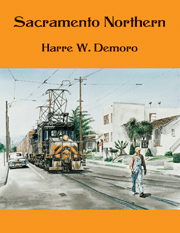Sacramento Northern
by Harre W. Demoro

The Sacramento Northern Railway was one of America's great electric interurban railways, offering almost any service and experience that the traveler might desire: high-speed trains, dining and parlor cars, and local streetcars. The SN had steep grades, a tunnel, picnic grounds in a redwood grove, long trestles, bridges, a ferryboat that carried an entire train across a freshwater bay, and a spectacularride over the San Francisco-Oakland Bay Bridge.
Passenger trains of the SN were a technological wonder of the day and operated on three voltages, using trolley poles, pantographs and third-rail shoes. Automatic cab signals guided the green interurban trains over the San Francisco-Oakland Bay Bridge.
From its earliest days, the SN also was a major freight carrier, using electric-powered equipment. Late at night, when passenger trains did not operate, electric freight motors hauled the agricultural products of the Sacramento Valley and the output of Bay Area factories.
Like most intercity electric railways, the SN was built by local capitalists involved in other enterprises; in this case, men who had sought riches in the reclamation projects and bountiful harvests of the Sacramento Valley, and the development of hydroelectric power. Unfortunately, like most electric intercity railways, the Sacramento Northern was almost always broke, but because the promoters built the line to high engineering standards for freight as well as passengers the steam-powered Western Pacific Railroad bought the interurban and turned it into a valuable network of freight feeders.
The book deals with more than trains and tracks: it sets the story in the context of its era: a time when California was emerging from the financial impact of the 1906 San Francisco earthquake. The Golden State was harnessing her big rivers, embarking on major irrigation projects and entering a period of economic boom that would make her America's most populous and wealthiest state; and the Sacramento Northern played a key role in that drama.
Included here are more than 470 rare photographs, many ofthem published for the first time, as well as detailed chapters on the history, finance, rolling stock, signals, power systems and terminals. Timetables, financial and traffic data, scale drawings of rolling stock, and tickets are also included and, in one chapter, the reader takes a ride on the Sacramento Northern in the mid-1930s. Maps were drawn especially by Seattle cartographer Wayne Hom, with an endsheet map by John Signor. Altogether, this is a rich and rewarding account of railroad history and operation.
Harre W. Demoro was a veteran Bay Area newspaperman and author of 11 other books on urban transportation, ferryboats and railroad history. Demoro, a native of Oakland, Calif., covered urban transportation for the San Francisco Chronicle. He wrote extensively for magazines and was technical editor of Mass Transit magazine from 1976 to 1984. He passed away in 1993 and is survived by a daughter, Kristin.
Also available: the Table of Contents of the book.
Particulars: Sacramento Northern by
Harre W. Demoro
Price: $70 Size:
352 pages, 8.5" x 11"; 471
photos; 20 maps and drawings, rosters, bibliography, index
ISBN: 978-1-930013-25-4
Publication date:
March 1, 2009
Distribution: Western Star Distributors, Lompoc, CA; or direct from
publisher.